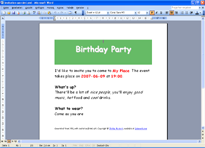invitation2wordml.xslt - Transforming XML to WordML (part of Office Open XML
)
The third lesson of transforming XML deals with the target format WordML, an
XML dialect introduced with MS Word 2003. In Office 2007 MS introduced
Office Open XML
; the WordML shown in this article still is a part of this
new format; a major difference is, that an Office Open XML document is
a zip file which contains (among other files) the WordML file.
If you're familiar with MS Word, you know that
this word processor has a lot of features. It's not surprising that these
complexity can be found in an WordML file. Therefore an WordML generating
XSLT program is more complex. But first, the steps if you want to transform
my invitaion.xml to WordML:
Download the sample XML file invitation.xml
Download the XSLT program invitation2wordml.xslt
(Download/View)
Run the XSLT program on the sample data, for example:
xalan.sh -IN ../invitation.xml -XSL invitation2wordml.xslt -OUT invitation-wordml.xml
You should get a WordML/XML file as the result of the transformation
(invitation-wordml.xml).
Open the transformation result in the XML enabled 2003 edition of MS Word 2003 or
take a look at the screenshot of the XML file viewed with Word 2003:

Since WordML is more complex than, for example, XHTML I won't
describe the XSLT listing in detail. Instead I will describe the structure of
a WordML file roughly.
Below you see an empty WordML file. The root element is of type wordDocument
.
WordML elements are declared in the namespace
http://schemas.microsoft.com/office/word/2003/wordml (prefix
in my example: word). Furthermore
you can mix WordML elements with common MS Office elements. The namespace
identifier for the latter is
urn:schemas-microsoft-com:office:office (prefix in my example: o).
o:DocumentProperties
contains elements which are common to MS Office
documents, while word:docPr
contains Word specific properties. Both are optional.
<word:wordDocument xmlns:word="http://schemas.microsoft.com/office/word/2003/wordml" xmlns:xml="http://www.w3.org/XML/1998/namespace" xml:space="preserve">
<o:DocumentProperties xmlns:o="urn:schemas-microsoft-com:office:office">
...
</o:DocumentProperties>
<word:docPr>
...
</word:docPr>
<word:styles>
<word:style word:type="paragraph" word:styleId="..." word:default="off">
...
</word:style>
<word:style word:type="paragraph" word:styleId="StandardPara" word:default="on">
...
</word:style>
<word:style word:type="character" word:default="off" word:styleId="...">
...
</word:style>
</word:styles>
</word:wordDocument> You can define styles, which you want to apply to more than one paragraph,
within the word:styles
elements. Word has two kinds of styles:
paragraph and character styles. Both are represented in the XML file
as a word:style
element; the type is controlled by the type
attribute.
The body carries paragraphs and other elements. A paragraph in WordML can look like this:
<word:p xmlns:word="http://schemas.microsoft.com/office/word/2003/wordml">
<word:pPr>
<word:pStyle word:val="event"></word:pStyle>
<word:r xmlns="http://schemas.microsoft.com/office/word/2003/wordml">
<word:t>Birthday Party
</word:t>
<word:br></word:br>
A paragraph has some properties, contained within word:pPr
. In this case
it's just a (somewhere else defined) paragraph style, referenced by a word:pStyle
element. One or more so called runs
hold the text of the paragraph, but not
directly within word:r
; the text is placed within
another element called word:t
. If you're already confused, it may please you
that some elements are named as in HTML, for example the empty word:br
which generates a line break. There are many more elements allowed at this point
of the file. You can control the formatting of the paragraph, adjust fonts, colors,
size and so on. To reduce complexity of the generated file, I use paragraph styles.
The referenced paragraph style, named event
, is defined like this:
<word:style xmlns:word="http://schemas.microsoft.com/office/word/2003/wordml" word:type="paragraph" word:styleId="event" word:default="off">
<word:basedOn word:val="StandardPara"></word:basedOn>
<word:name word:val="Event"></word:name>
<word:pPr>
<word:jc word:val="center"></word:jc>
<word:shd word:val="clear" word:color="auto" word:fill="66BB66"></word:shd>
<word:spacing word:before="100" word:before-autospacing="off" word:after="300" word:after-autospacing="off"></word:spacing>
</word:pPr>
<word:rPr>
<word:b></word:b>
<word:shadow word:val="on"></word:shadow>
<word:sz word:val="72"></word:sz>
<word:color word:val="ffffff"></word:color>
</word:rPr>
</word:style> A style has a word:styleId
to uniquely identify it. It can be
word:basedOn
some other paragraph definition, which makes it easier
to define derivated styles. Derivated styles may differ from the
base style in, for example, just the text alignment or font size etc.
The word:name
of a style is display in Word in the style selection menu.
The main purpose of a paragraph style definition is the definition
of the paragraph properties (word:pPr
) and the run properties
(word:rPr
). The event style defines for the paragraph
a centered justification, some shading and spacing; and for the runs of
event paragraphs it defines a bold face (word:b
),
a turned on word:shadow
, a size of 72, and a white word:color
.
The generation of such kind of markup with XSLT is analogue to
the gerneration of XHTML or XSL-FO, which I already described. Therefore
you should be able to understand my XSLT program. In order to be able
to generate more sophisticated WordML documents, you certainly need more
details about WordML. You can learn a little bit more by looking at
my XSLT. The details about WordML are described in
Microsofts
reference documentation. In case you discover
problems with your XML processing, don't forget: Linkwerk accepts money
for consulting, development and data conversion ;-).
Send us a mail.
© 2005-2007, Stefan Mintert, All rights reserved
Legal notice: If you want to use my XSLT script, please read the
Office 2003 XML Reference Schema Patent License.
While I don't call my piece of code a product
, I have to display the following note
(cited from the linked page at time of writing this, 2005):
This product may incorporate intellectual property owned by Microsoft Corporation. The terms and conditions upon which Microsoft is licensing such intellectual property may be found at http://msdn.microsoft.com/library/en-us/odcXMLRef/html/odcXMLRefLegalNotice.asp.
Update 2007: With MS Office 2007 the situation has changed. Office Open XML is an
open
Ecma standard and is about to become a ISO standard. There
shouldn't be any restrictions in using the format; but I'm not a lawyer.
Read the copyright stuff from MS, Ecma or ISO and &ndash if in doubt –
ask your lawyer...


